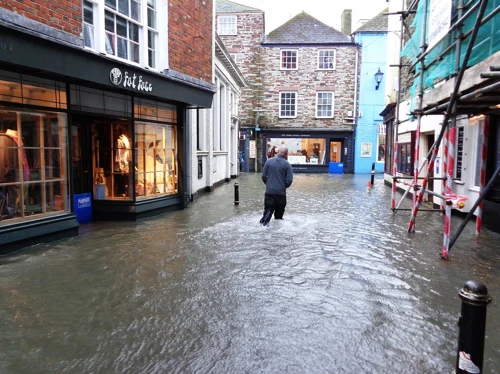Floods can cause massive damage to homes in a short amount of time. They can be sudden and unpredictable, leaving homeowners feeling shocked, stressed, and unsure where to start. Whether caused by heavy rain, melting snow, broken pipes, or storms, floods can ruin furniture, weaken walls, and create dangerous mold problems.
The good news is that you can prepare for floods before they happen. With the right steps, you can protect your home, reduce damage, and recover faster. In this blog, you will learn the most important flood restoration tips every homeowner should know before disaster strikes. These tips will help you take action at the right time and avoid costly mistakes.
Know Your Flood Risk
The first part of flood preparation is to understand your risk. There are certain areas that are more likely to flood than others, but even if you do not live near a river or ocean, flooding can still happen. Heavy rain, poor drainage, or water main breaks can all result in water coming into your home.
You can find out your risk level by looking at flood maps on local government websites or the Federal Emergency Management Agency (FEMA) website. Knowing your risk will help you decide whether you need flood insurance, drainage reinforcements, or other forms of protection.
Protect Your Home Before a Flood
If you take action before a flood happens, you can prevent much of the potential damage. Here are some smart steps to prepare your home:
- Seal cracks in your basement walls and foundation.
- Install a sump pump to remove water quickly during heavy rain.
- Keep your gutters and downspouts clean so water flows away from your home.
- Raise electrical outlets and switches above expected flood levels.
- Move important belongings and electronics to higher shelves.
These actions can make a big difference when floodwaters start rising.
Create a Family Emergency Plan
A flood can happen with little warning, so you need a plan to keep your family safe. Your emergency plan should include:
- An evacuation route that avoids low areas and bridges.
- A meeting point in case family members get separated.
- An emergency kit with food, water, medicine, batteries, and flashlights.
- Important phone numbers, including your insurance company.
Practice your plan so everyone knows exactly what to do if you need to leave quickly.
Act Fast When Flooding Starts
If you get a flood warning or notice water entering your home, take action immediately. Safety should be your first concern.
- Turn off the power at the main breaker to prevent electrical shocks.
- Move valuables to higher areas if it is safe to do so.
- Avoid walking or driving through moving water. Even six inches of water can knock you down, and one foot can sweep a car away.
- Listen to local alerts for instructions on evacuation.
Quick action can save both lives and property.
Start the Cleanup as Soon as Possible
When the water recedes and it is safe to return, start cleaning up right away. The sooner water is removed from your home, the less damage will be done.
Open doors and windows to allow air to circulate through your house. Fans, wet/dry vacuums, and dehumidifiers can be used to extract moisture. Wear protective clothing and disinfect all contaminated surfaces if the floodwater is contaminated (e.g., sewage).
Document All Damage for Insurance
Do not dispose of anything yet, document all of the damage. Take clear photos and videos of all damaged surfaces, including walls, floors, furniture, and personal items. Create a written list of damaged items and their value.
Inform your insurance company as soon as possible. Your detailed records will help to speed up the claims process.
Get Professional Help When Needed
While you can handle some cleanup tasks yourself, certain situations require expert help. Flood damage can be more serious than it looks, and hidden moisture can lead to mold or structural issues.
This is where fire and water damage restoration professionals come in. They have the right equipment to remove water, dry your home completely, and repair damaged areas safely. Professionals also know how to handle contaminated water and mold growth, making your home safe to live in again.
Prevent Mold from Spreading
Mold can start to grow within 24–48 hours after a flood, so you must act quickly. Remove wet carpets, rugs, and furniture that cannot be completely cleaned and dried.
Clean hard surfaces with a mold-killing solution and use dehumidifiers around the clock until your home is dry. If you find a large mold area, call a certified mold removal expert.
Take Steps to Reduce Future Flood Damage
After you restore your home, you can work on preventing future problems. Consider these improvements:
- Install flood vents in basement walls to allow water to pass through without causing damage.
- Improve your landscaping to direct water away from your house.
- Add barriers such as sandbags or small retaining walls during heavy rain.
- Upgrade your drainage system so it can handle large amounts of water.
By making these changes, you will be better prepared for the next flood.
Stay Alert and Prepared
Flood preparedness is not a one-time thing and then you’re finished. Keep your emergency kit supplied, check your sump pump regularly, and stay informed about local weather alerts.
If you know a storm is on its way, take rushed steps such as moving valuables to higher levels, unplugging electronics, and securing outdoor furniture.
Final Thoughts
Floods are dangerous and can cause serious damage, but preparation can make a big difference. By knowing your risk, protecting your home, acting quickly during an emergency, and getting the assistance of professionals when you need it, you can recover more safely and quickly.
Remember, you can’t control when a flood hits, but you can control how prepared you are. The sooner you prepare, the less you will lose — and the faster your home will return to normal.
